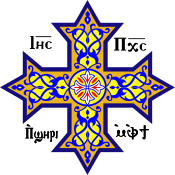Coptic Catholic Church
| Coptic Catholic Church | |
|---|---|
| Classification | Catholic |
| Orientation | Eastern Catholic, Alexandrian Rite |
| Polity | Episcopal |
| Structure | Patriarchal |
| Leader | Patriarch Ibrahim Isaac Sidrak |
| Associations | Congregation for the Oriental Churches |
| Region | Egypt, with communities in Asia, Australia, Europe, and North America |
| Headquarters | Cairo |
| Separated from | Coptic Orthodox Church of Alexandria |
| Congregations | 161 (2010) |
| Members | 163,630 (2010) |
| Ministers | 243[1] |
| Official website | coptcatholic.net |
| Part of a series on the |
| Copts |
|---|
| Culture |
| Regions |
| Denominations |
|
|
The Coptic Catholic Church is an Eastern Catholic particular Church in full communion with the Catholic Church. The Coptic Catholic Church uses the Alexandrian Rite, and uniquely among Eastern Catholic Churches, uses the Coptic language in its liturgy.
The current Coptic Catholic Patriarch of Alexandria is Ibrahim Isaac Sidrak, who replaced Antonios Naguib in 2013. The offices of the Patriarchate are located in Cairo. The patriarchal Cathedral of Our Lady of Egypt is in Nasr City, a suburb of Cairo.
History
Beginnings
At the Council of Florence on February 4, 1442, a Coptic Orthodox delegation signed the Cantate Domino, a document for the formal union with the Catholic Church and the bishop of Rome. With little support in Egypt, the document had no effect. In the 17th century, missionaries, primarily Franciscans, started to come to the Copts. In 1630, a Cairo mission of the Capuchin Order was founded. The Jesuits came in 1675.[2] In 1713, the Coptic Patriarch of Alexandria again submitted to Rome, but as in 1442, the union was not of long duration.[3]
In 1741, Coptic Bishop Anba Athanasius of Jerusalem became a Catholic.[3] In 1781, he was appointed by Pope Benedict XIV as Vicar Apostolic of the less than 2,000 Egyptian Coptic Catholics.[2] Eventually, Athanasius returned to the Coptic Orthodox Church and others served as Catholic Vicar Apostolic.[2]
Patriarchate
Under the assumption that the Ottoman viceroy wanted a Catholic patriarch for the Coptic Catholics in 1824, the Pope established the Patriarchate of Alexandria[2] from the Apostolic Vicariate of Syria, Egypt, Arabia and Cyprus[4] but it was basically titular.[2] The Ottomans in 1829 allowed the Coptic Catholics to build their own churches.[2]
The number of Catholics of this Rite increased to the point that Leo XIII in 1895 restored the Catholic patriarchate.[3] He initially named Bishop Cyril Makarios as Patriarchal Vicar. Makarios then presided over a synod, which led to the introduction of some Latin practices. In 1899, Leo appointed Makarios as Patriarch of Alexandria of the Copts, taking the name Cyril II. He resigned in 1908 at the request of the Pope over a controversy. The patriarchate seat remained vacant until an election in 1947[2] and was administered by Apostolic Administrator.[4]
Hierarchy
The Coptic Catholic Church sui juris comprises a single ecclesiastical province, covering Egypt only. The Patriarch is the sole Metropolitan Archbishop, retaining the ancient title Alexandria but his actual see is in Egypt's modern capital Cairo.
He has seven suffragan bishops, throughout Egypt: the eparchies of Alexandria, Assiut, Guizeh, Ismayliah, Luqsor, Minya and Sohag.
Religious orders
The Coptic Catholic Church does not have Coptic monasteries. Instead the Church has religious congregations such as the three communities for women: the Sisters of the Sacred Heart, the Coptic Sisters of Jesus and Mary (both based in Egypt) and the Egyptian Province of the Little Sisters of Jesus. There is also a community of male Franciscans.[2]
Educational and health services
Most candidates for the priesthood are trained at St. Leo's Patriarchal Seminary, in suburban Cairo. More than 100 Coptic Catholic parishes administer primary schools, and some have secondary schools as well. The church maintains a hospital, a number of medical dispensaries and clinics, and several orphanages.[citation needed]
See also
| Part of a series on |
| Particular churches sui iuris of the Catholic Church |
|---|
| Particular churches are grouped by liturgical rite |
| Alexandrian Rite |
| Armenian Rite |
| Byzantine Rite |
| East Syriac Rite |
| Latin liturgical rites |
| West Syriac Rite |
|
Eastern Catholic Churches Eastern Catholic liturgy |
- List of Coptic Catholic Patriarchs of Alexandria
- Eastern Catholicism
- List of Catholic dioceses (structured view)
- Monasticism
- Oriental Orthodox Church
References
- ^ Roberson, Ronald G. "The Eastern Catholic Churches 2010" (PDF). Eastern Catholic Churches Statistics. Catholic Near East Welfare Association. Retrieved 28 December 2011.
- ^ a b c d e f g h Roberson, Ronald G. "The Coptic Catholic Church". Eastern Catholic Churches. Catholic Near East Welfare Association. Retrieved 27 January 2012.
- ^ a b c
 Herbermann, Charles, ed. (1913). Churches "Eastern Churches". Catholic Encyclopedia. New York: Robert Appleton Company.
Herbermann, Charles, ed. (1913). Churches "Eastern Churches". Catholic Encyclopedia. New York: Robert Appleton Company. {{cite encyclopedia}}: Check|url=value (help) - ^ a b "Patriarchal See of Alexandria". Catholic Dioceses in the World. GCatholic.org. Retrieved 27 January 2012.
External links
- Coptic Catholic Patriarchate official website
- Coptic Catholic website
- GigaCatholic
- Article on "Life in a Coptic Catholic Village"
- "Italian-language video on the Coptic Catholic Church"
- "Video of the ordination of Coptic Catholic deacons"
- Article on the Coptic Catholic Church by Ronald Roberson on the CNEWA web site
- Common Declaration of Pope Paul VI and Pope Alexandria Shenouda III, 1973

